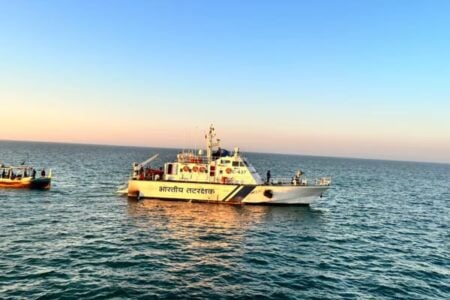 INTERNATIONAL DESK: Myanmar’s Coco Islands in the Bay of Bengal have long been the subject of geopolitical intrigue. The most common allegation is that since the early 1990s, Myanmar has allowed a Chinese signals intelligence facility on the archipelago. Little evidence exists for such a facility, bar a heavily weathered radar station, but recent satellite photographs have raised concerns, especially for India, of increased activity on the islands, writes policy institute Chatham House.
INTERNATIONAL DESK: Myanmar’s Coco Islands in the Bay of Bengal have long been the subject of geopolitical intrigue. The most common allegation is that since the early 1990s, Myanmar has allowed a Chinese signals intelligence facility on the archipelago. Little evidence exists for such a facility, bar a heavily weathered radar station, but recent satellite photographs have raised concerns, especially for India, of increased activity on the islands, writes policy institute Chatham House.
The militarization of the Coco Islands could pose a significant security challenge to India
This has implications for India’s strategic interests in the region, as New Delhi seeks to counter China’s growing influence in South Asia and the Indian Ocean region. With the Coco Island developments, India may soon face a new airbase close by in a country increasingly tied to Beijing.
The militarization of the Coco Islands by the Tatmadaw, combined with the wider Chinese developments occurring inland, could pose a significant security challenge to India and its navy. The Andaman and Nicobar Islands provide India’s Eastern Fleet strategic depth in the Bay of Bengal and command approaches to the Strait of Malacca, according to analysis by Chatham House.
The islands are experiencing a steady makeover, with tell-tale signs of military modernization and facilities to support aircraft. Instead of the phantom Chinese intelligence post still prevalent in the popular imagination, the latest images reveal that Myanmar may soon be intending to conduct maritime surveillance operations from Great Coco Island, the largest in an isolated archipelago that lies just 55 kilometres north of India’s strategic Andaman and Nicobar Islands.
Beijing has staked a large investment in Myanmar to access Indian Ocean sea lanes.
The past two years of civil war in Myanmar have left it isolated internationally with the military junta, known as the Tatmadaw, increasingly fragile. Beijing has staked a large investment in the country via the China-Myanmar Economic Corridor to access Indian Ocean sea lanes as a way to bypass the Strait of Malacca, which has acted as a critical sea lane for shipping destined for China’s east coast, and direct energy imports instead over land into China’s Yunnan province, Chatham House reported.
Chinese commercial shipping could soon bypass the strait and offload their cargo in Myanmar, nullifying India’s advantage. Meanwhile, an expanded airbase on Great Coco opens the possibility that India may soon have to contend with Tatmadaw eyes watching the movements of its warships.
Another concern is that if China were to further apply pressure to the Tatmadaw, leveraging naval intelligence acquired from surveillance flights from Great Coco for desperately needed economic investment, it would give Beijing a key regional advantage over New Delhi, Chatham House reported.
In the 1990s, stories around Great Coco went from extravagant to outlandish
Fears that China could use Myanmar to monitor the Indian navy are not new, especially in the context of the Great Coco. Conspiracy theories dominate the recent history of the Coco Island chain.
Despite efforts to debunk them, they underpin almost all the conjecture around Great Coco, with any activity by Myanmar to reinforce its military presence seen as having a Chinese hand behind it. It is essential then to sort fact from fiction, Chatham House reported.
Growing evidence suggests Myanmar’s military coup has increased Beijing’s influence in the country. With Myanmar’s armed forces struggling to control large swaths of the country and with the economy in freefall, China seems to be shoring up the regime and protecting its investments for now.
Chinese companies are believed to be operating on the ground, building major infrastructure projects such as deep-water ports, while the junta is allocating the few troops it has left to protect them.
In the early 1990s, the first rumours emerged that the Chinese military had established a 45-50 metre antenna tower on Great Coco, equipped with signals intercept equipment. The timing broadly correlates with a warming of ties between Myanmar and Beijing following the 1988 crackdown on pro-democracy protests in Yangon, Chatham House reported.
As with today, this period saw Myanmar isolated internationally and becoming a major export market for military equipment for Beijing in exchange for raw materials.
As the decade progressed the stories around Great Coco went from extravagant to outlandish.
The antenna tower was turned into a full signals intelligence post, manned by the People’s Liberation Army, and then evolved into stories of Beijing fully leasing the islands from Myanmar.
Journalists in South Asia frequently ran stories of China tracking missile tests and launches by India’s space agency from Great Coco. High-ranking officials in New Delhi did little to dissuade the press of these notions. Indian officials cited alleged Chinese radar bases at Manaung Island, Hainggyi Island, Zar Dar Gyi Island, as well as Great Coco. The idea of a major Chinese presence in Myanmar’s islands percolated popular discourse in South Asia for more than a decade, with western analysts guilty of adding to the fever, Chatham House reported.
In 2005, Admiral Arun Prakash, India’s chief of naval staff, set the record straight, stating there was no Chinese military installation of any kind on Great Coco. That same year, Myanmar’s junta invited Indian defence officials to visit Great Coco, confirming the presence of an airstrip but no visible Chinese military presence. There were no radar dishes or antennae farms collecting information and probably never were.
To this day rumours of a Chinese intelligence post persist, but the available evidence points to the facilities being operated by the Tatmadaw. Instead of a non-existent Chinese intelligence post, the Bay of Bengal may soon have to contend with an airbase hosting Myanmar’s air force, Chatham House reported.
At Present, the salience of Great Coco and its utility as a base for aircraft to survey the Indian Ocean is growing. The recent photographs released by Maxar add to the body of evidence indicating that the facilities on Great Coco are steadily being upgraded. The runway has been lengthened and new hangars are being built, combined with a limited land reclamation project.
With the Myanmar junta once again isolated by western sanctions and beset by instability from within, and with ties between Beijing and the West at their lowest since Tiananmen Square, the conditions mirror what was seen in 1988, but to a far greater extent. Myanmar’s junta has few friends left and the few assets it has are increasingly dependent on Chinese capital to sustain.
Great Coco is thus potentially a point of future leverage. Were Myanmar to get the base fully established, surveillance flights could track movements to and from the Andaman and Nicobar Islands. Given China’s well-established intelligence practices, local intelligence from Great Coco could find its way, either through espionage or consent, to Shanghai, Chatham House reported.
For India, Great Coco Island was in the past a place for outlandish theories. It may now become a real point of concern. (ANI)
iNews covers the latest and most impactful stories across
entertainment,
business,
sports,
politics, and
technology,
from AI breakthroughs to major global developments. Stay updated with the trends shaping our world. For news tips, editorial feedback, or professional inquiries, please email us at
[email protected].
Get the latest news and Breaking News first by following us on
Google News,
Twitter,
Facebook,
Telegram
, and subscribe to our
YouTube channel.



